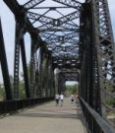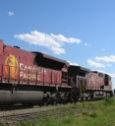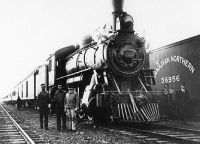| |

Home
Rails and
Trails
Innovative
Transport
Sustainable
Community
Heritage
Rail
Heritage
Preservation
Regional
Rail History
Alberta
Central
Railway
Calgary
and
Edmonton
Railway
Canadian
Northern
Western
Railway
Canadian
Northern
Railway
Red Deer
and Area
Personal
Profile
Contact Me
Links
Site Map





|
Canadian Northern
Railway in Central Alberta
For many years, William Mackenzie and Donald Mann worked as contractors
building several sections of railway lines in western and eastern
Canada, including the Calgary and Edmonton Railway in 1890-91. In 1895,
they had the opportunity to purchase the charter of a proposed railway
line in Manitoba. There was considerable provincial support for some
competition to the Canadian Pacific Railway to keep freight rates at a
reasonable level.
In 1898, they acquired the Edmonton District Railway renaming it to the
Edmonton, Yukon and Pacific Railway, originally chartered in 1896 to
provide a rail line from Edmonton to the Yukon gold rush. In 1900, the
new railway built the low level bridge over the North Saskatchewan River
linking Edmonton with Strathcona, connecting with the Calgary and
Edmonton Railway in 1902.
The partnership resulted in the creation of a prairie network of railway
lines and a new transcontinental railway, the Canadian Northern Railway,
federally chartered in 1899. Their strategy included building into areas
with high agricultural potential, minimum standards to reduce expenses
and hasten commencement of service and low freight rates.
The railway's east-west main line reached Edmonton in 1905. By 1909, the
main line was improved and a higher standard of construction was
incorporated into new branch lines. By 1909, the federal government
determined that all branch lines would be financed by provincial
governments and the new governments of Alberta and Saskatchewan were
eager to expand the rail network.
In Alberta, several branches were incorporated as separate companies in
order to get maximum funding from the provincial government. Once
completed, the Canadian Northern would operate and maintain the branch
lines. Two of the lines incorporated separately were the Alberta Midland
and the Canadian Northern Western.
The Alberta Midland Railway was incorporated in 1909 with Mackenzie and
Mann as two of the shareholders. The company awarded the construction
contracts of up to five branchlines to Mackenzie and Mann.
 In order to discourage east-west expansion of the competing Grand Trunk
Pacific Railroad between Calgary and Edmonton, one of the contracts was
for a line from the Canadian Northern main line at Vegreville south to
Camrose built in 1909, extended east of Buffalo Lake to Stettler, Big
Valley and Drumheller in 1911 and on to Calgary in 1914. Also in 1914, a
line connecting Camrose with Strathcona was built, completing a direct
line between the two major cities. Big Valley was chosen to become the
divisional point for the line. In order to discourage east-west expansion of the competing Grand Trunk
Pacific Railroad between Calgary and Edmonton, one of the contracts was
for a line from the Canadian Northern main line at Vegreville south to
Camrose built in 1909, extended east of Buffalo Lake to Stettler, Big
Valley and Drumheller in 1911 and on to Calgary in 1914. Also in 1914, a
line connecting Camrose with Strathcona was built, completing a direct
line between the two major cities. Big Valley was chosen to become the
divisional point for the line.
Most of the other lines in the charter were never built. The Canadian
Northern amalgamated the branch lines into the parent company as soon as
the government funding was received.
 Even
before the Alberta Midland Railway was completed between Camrose and
Drumheller, a charter was obtained in 1910 to build the Canadian
Northern Western Railway from Warden, a point on the AMR south of
Stettler west to the Brazeau Colleries near Nordegg west of Rocky
Mountain House. Construction started in 1911 at Warden reaching Sylvan
Lake and a spur line to Red Deer that was originally planned to become
part of a shorter north-south route between Calgary and Edmonton. It
reached Rocky Mountain House in 1912 roughly running parallel with the
Alberta Central Railway and extended to Nordegg late the following year.
Rather than build its own bridge across the North Saskatchewan River at
Rocky, the CNWR leased the bridge built by the Alberta Central. Even
before the Alberta Midland Railway was completed between Camrose and
Drumheller, a charter was obtained in 1910 to build the Canadian
Northern Western Railway from Warden, a point on the AMR south of
Stettler west to the Brazeau Colleries near Nordegg west of Rocky
Mountain House. Construction started in 1911 at Warden reaching Sylvan
Lake and a spur line to Red Deer that was originally planned to become
part of a shorter north-south route between Calgary and Edmonton. It
reached Rocky Mountain House in 1912 roughly running parallel with the
Alberta Central Railway and extended to Nordegg late the following year.
Rather than build its own bridge across the North Saskatchewan River at
Rocky, the CNWR leased the bridge built by the Alberta Central.
The Canadian Northern Western also had permission to build an extensive
rail network north and east of Edmonton and near Medicine Hat but most
of it wasn't built.
The Canadian Northern became part of the Canadian Government Railways in 1918 and
absorbed into the newly-created Canadian National Railways in 1919. In
1923, modifications were made at Alix South Junction (on the former
Grand Trunk Pacific Railway) as part of a consolidation and
rationalization of the various railroads comprising the new CNR. Mirror
replaced Big Valley as the divisional point for train crews for the
Brazeau Subdivision as well as the north-south Calgary-Edmonton former
Grand Trunk Pacific line.
The line between Rocky Mountain House and Nordegg (Brazeau) was formally
abandoned in 1986, although the line hadn't been used for almost thirty
years after the mines closed.
In 1986, the Central Western Railway, founded by Thomas Payne, became
western Canada's first modern day short line railroad when it acquired
the Alberta Midland/Canadian Northern (Stettler subdivision of Canadian
National) line between Ferlow junction south of Camrose and Munson
junction south of Morrin. In 1992, the Central Western acquired the
Coronation subdivision of Canadian Pacific. Much of the railway was
abandoned except for the portion between Stettler and Big Valley which
was sold to Alberta Prairie Railway Excursions in 1998.
 Today, Alberta Prairie runs popular steam excursions almost year-round
(except for dead of winter) using either a 1920 Consolidation steam
locomotive (no. 42), a 1944 Mountain steam locomotive (no. 6060) or a
1958 SW1200 diesel switcher. The excursion between Stettler and Big
Valley usually includes a meal, entertainment and a hold-up. Today, Alberta Prairie runs popular steam excursions almost year-round
(except for dead of winter) using either a 1920 Consolidation steam
locomotive (no. 42), a 1944 Mountain steam locomotive (no. 6060) or a
1958 SW1200 diesel switcher. The excursion between Stettler and Big
Valley usually includes a meal, entertainment and a hold-up.
The Canadian Northern second class station and a grain elevator at Big
Valley have been restored and an interpretive centre developed around
the remnants of the former roundhouse. The line is also used as a
training facility. The Canadian Northern station at Camrose has also
been restored and is home to an extensive library and archives on
railway history. It also has a tea room, museum, gift shop, garden
railway and park. The Meeting Creek third class station and a grain
elevator have also undergone restoration.
The Canadian Northern
Western Railway Brazeau Subdivision (Canadian National)
The Calgary and Edmonton Railway
(now Canadian Pacific Railway main north-south line)
The Calgary and Edmonton Railway
near Red Deer
The Alberta Central Railway
(abandoned Canadian Pacific Alberta Central subdivision)
Railway Heritage Preservation
in Central Alberta
 |
|
|